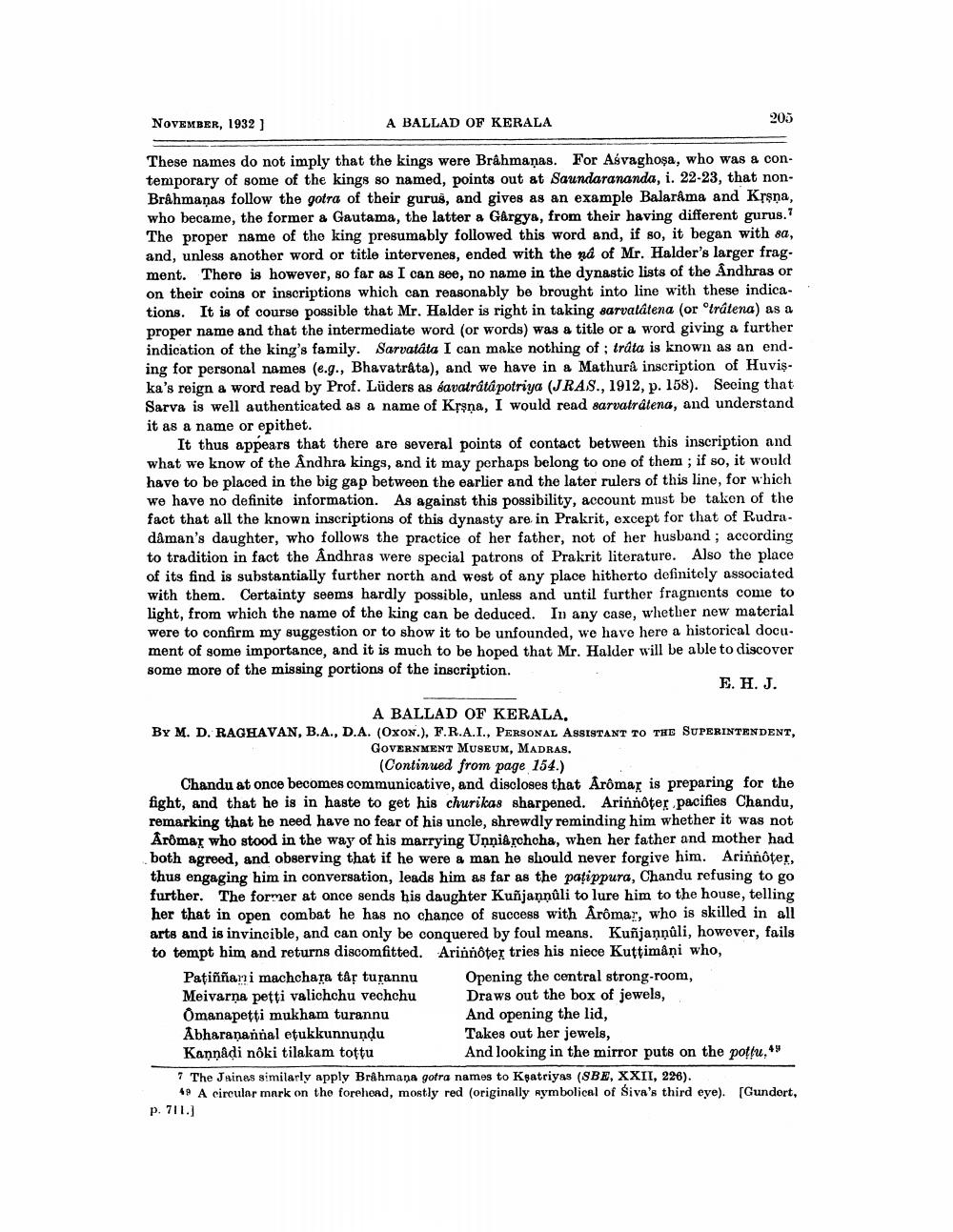________________
A BALLAD OF KERALA
205
NOVEMBER, 1932]
These names do not imply that the kings were Brâhmaņas. For Asvaghosa, who was a contemporary of some of the kings so named, points out at Saundarananda, i. 22-23, that nonBrahmaņas follow the gotra of their gurus, and gives as an example Balarama and Kṛṣṇa, who became, the former a Gautama, the latter a Gârgya, from their having different gurus." The proper name of the king presumably followed this word and, if so, it began with sa, and, unless another word or title intervenes, ended with the ná of Mr. Halder's larger fragment. There is however, so far as I can see, no name in the dynastic lists of the Andhras or on their coins or inscriptions which can reasonably be brought into line with these indications. It is of course possible that Mr. Halder is right in taking sarvalâtena (or trútena) as a proper name and that the intermediate word (or words) was a title or a word giving a further indication of the king's family. Sarvatâta I can make nothing of; tráta is known as an ending for personal names (e.g., Bhavatrâta), and we have in a Mathurâ inscription of Huviska's reign a word read by Prof. Lüders as savatratápotriya (JRAS., 1912, p. 158). Seeing that Sarva is well authenticated as a name of Krsna, I would read sarvatratena, and understand it as a name or epithet.
It thus appears that there are several points of contact between this inscription and what we know of the Andhra kings, and it may perhaps belong to one of them; if so, it would have to be placed in the big gap between the earlier and the later rulers of this line, for which we have no definite information. As against this possibility, account must be taken of the fact that all the known inscriptions of this dynasty are in Prakrit, except for that of Rudradâman's daughter, who follows the practice of her father, not of her husband; according to tradition in fact the Andhras were special patrons of Prakrit literature. Also the place of its find is substantially further north and west of any place hitherto definitely associated with them. Certainty seems hardly possible, unless and until further fragnients come to light, from which the name of the king can be deduced. In any case, whether new material were to confirm my suggestion or to show it to be unfounded, we have here a historical document of some importance, and it is much to be hoped that Mr. Halder will be able to discover some more of the missing portions of the inscription.
E. H. J.
A BALLAD OF KERALA.
BY M. D. RAGHAVAN, B.A., D.A. (OXON.), F.R.A.I., PERSONAL ASSISTANT TO THE SUPERINTENDENT, GOVERNMENT MUSEUM, MADRAS.
(Continued from page 154.)
Chandu at once becomes communicative, and discloses that Arômar is preparing for the fight, and that he is in haste to get his churikas sharpened. Arinnôter pacifies Chandu, remarking that he need have no fear of his uncle, shrewdly reminding him whether it was not Aromax who stood in the way of his marrying Unniârchcha, when her father and mother had both agreed, and observing that if he were a man he should never forgive him. Arinnôter, thus engaging him in conversation, leads him as far as the patippura, Chandu refusing to go further. The former at once sends his daughter Kuñjaņņûli to lure him to the house, telling her that in open combat he has no chance of success with Arômar, who is skilled in all arts and is invincible, and can only be conquered by foul means. Kuñjaņņûli, however, fails to tempt him and returns discomfitted. Arinñôter tries his niece Kutțimâņi who,
Patiññani machchara târ turannu Meivarna petti valichchu vechchu Omanapetti mukham turannu Abharanannal etukkunnundu Kannadi nôki tilakam tottu
Opening the central strong-room, Draws out the box of jewels,
And opening the lid,
Takes out her jewels,
And looking in the mirror puts on the pottu.+
49
7 The Jainas similarly apply Brahmana gotra names to Ksatriyas (SBE, XXII, 226).
49 A circular mark on the forehead, mostly red (originally symbolical of Śiva's third eye). [Gundert,
p. 711.]




